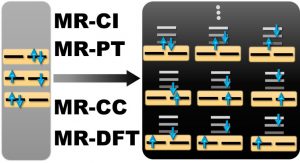Another paper working on improving the efficiency of surface hopping dynamics just appeared, this time in JCTC: “Surface hopping within an exciton picture – An electrostatic embedding scheme.” authored by M. F. S. J. Menger, F. Plasser, B. Mennucci, and L. González. In this paper, we explored the possibility of running nonadiabatic dynamics simulations within an exciton model. The main challenge in this endeavour was to derive a consistent energy expression for combining QM/MM electrostatic embedding calculations of the different chromophores.

To test the implementation, we ran simulations on a molecular dyad, where full TDDFT nonadiabatic dynamics simulations were available. Good agreement was found.
The method was implemented in the SHARC molecular dynamics package.
